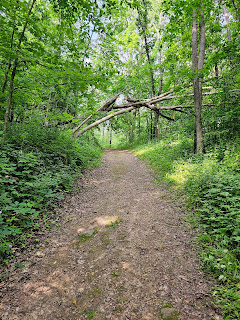We went wandering and ended up at Pendarvis in Mineral Point. Here is a little history...
In the early 19th century, lead mining was more promising and attractive than either the fur trade or farming to potential settlers of the southwestern corner of the state. The presence of lead was no secret. Members of the Ho-Chunk, Mesquaki (Fox), Sauk and other tribes had mined lead for hundreds of years before French fur traders arrived in the 1600s. Despite the land that would become Mineral Point in 1827 not being open for white settlement, hundreds of miners and settlers illegally poured into the region, violating the treaty rights of native nations settled there.
The lead mining boom was on, and Mineral Point became a
thriving commercial center that housed one of Michigan Territory’s first land
offices and served as a territorial county seat. The boom continued into early
Wisconsin statehood, when lead and zinc mining and processing became the
dominant economic activity in the region.
Neal and Hellum established the Pendarvis House restaurant
in 1935. They specialized in serving tea, saffron cake, scones, preserves, and
simple Cornish pasties, utilizing recipes passed on from Neal’s own
grandmother, a Cornish immigrant in the mid-1800s. They ended up earning a
national reputation for authentic Cornish fare and welcomed diners from every
state in the Union and many foreign countries. They operated the restaurant for
35 years before retiring in 1970.
The dining room was small and at street level. It would have been a tight fit!
Pendarrvis House Restaurant was named as a top seven restaurant I the country by the Saturday Evening Post and appeared in publications such as National Geographic and Life Magazines. The restaurant was a favorite of Duncan Hines, who visited twice and listed the restaurant in the early editions of his guidebook, Adventures in Good Eating.
All in all, Bob Neal and Edgar Hellum restored six historic
stone and stone-and-log cottages at Pendarvis. They began their preservation
work in 1935 by saving the first Cornish miner's cottage from demolition. They
later bought and restored additional structures to create what is now the
Pendarvis Historic Site.
TRELAWNY was the third building bought and restored by Bob and Edgar in the late 1930s and was the home they shared for 37 years. Richard Thomas and James Carbis, Cornish stonemasons, built this house in late 1842/early 1843. The original four room structure housed nine people. The kitchen, located in the back of the house, was added during the 1930s restoration and serviced the adjacent restaurant. Bob and Edgar entertained guests and friends here. The first-floor rooms still appear much as they did while they lived here in the 1940s.
The buildings that make up the site include:
Pendarvis: The first cottage they restored, built around
1845, was where they opened a restaurant to fund further preservation.
Polperro: A two-and-a-half-story house built around 1842.
Trelawny: The third building they bought and restored, which
served as their home for 37 years.
Tamblyn's Row: A row of three adjacent stone structures,
which includes the Martin Cabin, the oldest building on the site.
They gave the buildings Cornish names to honor the immigrant
miners who originally built them. In 1971, Neal and Hellum sold the restored
buildings to the Wisconsin Historical Society, and they were opened to the
public as the Pendarvis Historic Site.
The site is fairly large and you could walk over a mile on trails if you want to explore it all!
This whole building was called Tamblyn's Row and all the buildings are connected. Part of it is used for Historical Society offices. The Pub is on the far right on the exposed lower level that you can't see in the photo.
MARTIN CABIN
The oldest structure on site, this cabin was built in 1841
and home to John and Christiana Martin and their five children. Both were
immigrants to Mineral Point, with John being one of the earliest Cornish
settlers in the early 1830s and Christiana arriving from Nova Scotia. Bob and
Edgar bought the entire Tamblyn’s Row structure and removed clapboard siding as
well as an addition from the cabin.
This Cornish pub in the basement of Tamblyn’s Row was created in the 1960s by Edgar and never existed before that time. After visiting Cornwall several times, Edgar was inspired to recreate a pub for Pendarvis. The leather trim comes from his uncle’s shoe factory in Stoughton. This room was most likely originally used as a cellar or kitchen
Al waiting for his pint!
A "figgy hobbin" is a traditional Cornish pastry
that is similar to a mince pie. The name comes from the Cornish dialect, where
"figgy" refers to raisins or currants and "hobbin" is
believed to be a diminutive of "oven". Historically, it was a humble
and rustic baked dish, but today it is often served as a dessert.
We had quite an adventure this day! Mineral Point looked like a nice clean town and the people were all friendly....and we even learned a little something along the way.
Until the next adventure...stay safe, keep exploring and do something that makes you smile everyday!




















































